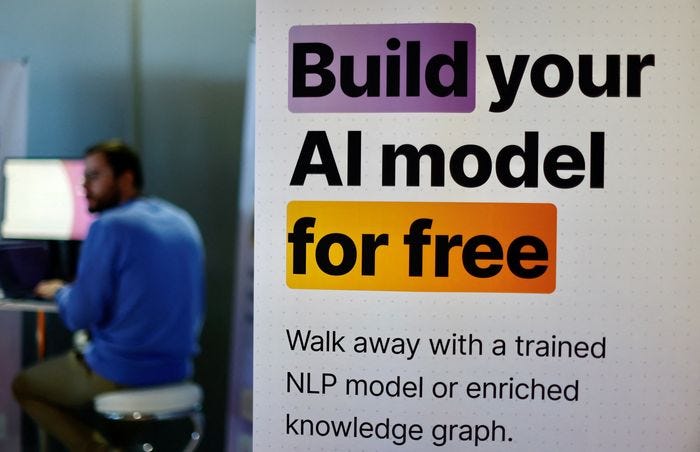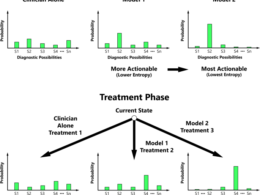institute for health transformation (IHT)
research and strategy institute
for continuous health transformation
Joaquim Cardoso MSc
Founder and Chief Researcher & Editor
February 17, 2023
EXECUTIVE SUMMARY
CIOs are facing increasing pressure to build new AI applications quickly as corporate teams demand cost-saving solutions.
However, CIOs have cited the high costs and time required to build, train, and roll out AI models as a major challenge.
- The median salary for data scientists rose to $156,000 in 2022, further increasing the costs of building AI applications.
- While historically businesses have focused on machine learning algorithms with the highest returns, there is increasing recognition that the value of smaller projects can be higher overall.
- Despite this, CIOs face competing priorities and a scarcity of data science talent.
- The growing popularity of generative AI applications like ChatGPT is adding to the pressure, and better tooling is needed to help CIOs move faster.
DEEP DIVE

Pressure Mounts on CIOs to Build More AI Apps (and Faster)
Tech chiefs are facing a rush of demand from corporate teams for AI apps they hope will save money without too much delay. ‘We cannot say “yes” to all their requests,’ says one CIO
The Wall Street Journal
By Isabelle Bousquette
Feb. 16, 2023 6:07
A tightening economy and the viral popularity of ChatGPT is spurring business interest in new enterprisewide AI applications.
But chief information officers say they cannot keep up with demand, citing the time and costs linked with building, training and rolling out AI models.
Magesh Sarma, chief information and strategy officer for AmeriSave Mortgage Corp., said his team has been inundated with requests to build AI apps aimed at tackling various cost issues.
“We cannot say ‘yes’ to all their requests,” said Mr. Sarma.
Algorithms, which can contain huge numbers of variables and constraints, are time-consuming and costly to build.
His team spent several years and approximately $20 million to $30 million in each of those years building one complex algorithm that performs some parts of the loan-underwriting process, he said.
He added that each algorithm is unique and requires varying amounts of time and capital, depending on its scope, scale and the number of variables.
His team spent several years and approximately $20 million to $30 million in each of those years building one complex algorithm that performs some parts of the loan-underwriting process, he said.
Generally, most of the cost is the salaries of data scientists and machine-learning engineers, who write algorithms, train them on data, test them, tweak them and then monitor them after deployment.
Compensation for these roles has risen, in part due to the scarcity of available candidates.
The median salary for data scientists in 2022 was $156,000, up from $151,840 in 2021, according to staffing firm Mondo, an Addison Group Company.
As rising interest rates pressure the mortgage industry, Mr. Sarma’s department has faced some cutbacks, he said.
But the AI team, which consists of 76 employees, has been one of the least affected because of its business value.
The algorithm that helps underwrite loans, for instance, helped AmeriSave scale its business nearly 1,200%, funding $24.2 billion in mortgage loans in 2020, up from $1.86 billion just two years earlier, Mr. Sarma said.
The algorithm that helps underwrite loans, for instance, helped AmeriSave scale its business nearly 1,200%, funding $24.2 billion in mortgage loans in 2020, up from $1.86 billion just two years earlier, Mr. Sarma said.
Historically, businesses have given priority to machine-learning algorithms with the highest returns, while hesitating to allocate resources to smaller projects with lesser returns that might cost a couple million dollars to build, said Andrew Ng, founder and chief executive of startup Landing AI and a former chief scientist of Baidu Inc.
However, the combined value of all of those smaller projects tends to actually be higher than the fewer high-value projects businesses often target, he said, and there’s a lot to be lost from holding back on fully expanding their use of machine-learning.
However, the combined value of all of those smaller projects tends to actually be higher than the fewer high-value projects businesses often target,
But for CIOs, it’s no easy feat tackling that “long tail” of smaller use cases.
“In general there’s so much work to be done that there are often competing priorities,” said Shelia Anderson, Aflac Inc.’s U.S. CIO.
Ms. Anderson has a system for evaluating the priority level of different possible machine-learning projects that come to her department via a request pipeline, she said. How long it takes to deliver value is a key part of that process, she said.
Ms. Anderson has a system for evaluating the priority level of different possible machine-learning projects that come to her department via a request pipeline, she said. How long it takes to deliver value is a key part of that process, she said.

One area she hasn’t been able to fully tackle is machine-learning algorithms to help with customer retention.
And while budget is a factor, she also said that finding enough of the right talent is the biggest barrier to moving more quickly.
At XPO Inc., CIO Jay Silberkleit said the organization employs 430 technologists and more than a dozen data scientists.
But he added that there are risks associated with trying to build more algorithms faster.
But he added that there are risks associated with trying to build more algorithms faster.
“If you rush it too much and you don’t have solid feedback loops, then people are just not going to trust the output, and they’re not going to trust that this is the right approach, and the whole thing just breaks down,” he said. “With AI, it’s an incremental sort of approach.”
Adding to the pressure is the exploding popularity of ChatGPT and other generative AI applications.
The technology’s humanlike ability to quickly generate business reports and other documents has nabbed the attention of corporate boardrooms, although some business-technology professionals are uneasy about integrating it into the enterprise stack, citing reliability issues.
although some business-technology professionals are uneasy about integrating it into the enterprise stack, citing reliability issues.
Mr. Ng said he believes that better tools, including the ones he is developing at Landing AI, could be part of the solution to helping CIOs move faster.
“There are tens of thousands of problems,” said Mr. Ng. “None of us can hire enough machine-learning engineers to solve all these problems one at a time. Which is why we need much better tooling.”
“There are tens of thousands of problems,” said Mr. Ng. “None of us can hire enough machine-learning engineers to solve all these problems one at a time. Which is why we need much better tooling.”
Mr. Ng’s tool essentially functions as a no-code way of building and training machine-learning algorithms that use computer vision.
Part of the reason it works for computer vision is because there are only a handful of image formats: PNG, GIF or JPEG. In other areas, such as supply chain, the data is so variegated it would be difficult to create a singular tool for building models, he said.
“Like electricity, AI shouldn’t be used just for one or two applications,” said Mr. Ng. “So I think there are numerous missed opportunities in many businesses to take advantage of this capability.”
“Like electricity, AI shouldn’t be used just for one or two applications,” said Mr. Ng. “So I think there are numerous missed opportunities in many businesses to take advantage of this capability.”
Originally published at https://www.wsj.com
Names mentioned (selected)
- Magesh Sarma, Chief Information and Strategy Officer for AmeriSave Mortgage Corp.
- Andrew Ng, founder and CEO of Landing AI and former Chief Scientist of Baidu Inc.
- Sheila Anderson, US CIO of Aflac Inc.
- Jay Silberkleit, CIO of XPO Inc.












